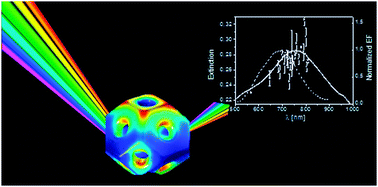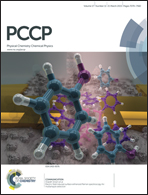Wavelength dispersion of the local field intensity in silver–gold nanocages†
Abstract
This study provides a combined theoretical and experimental analysis of the far-field (extinction) and of the near-field (SERS enhancement) spectral distribution in hollow nanoparticles, that is, silver–gold nanocages (NCs). Chitosan protected NCs have been synthesized by a galvanic replacement-based procedure: their morphological properties and chemical composition have been characterized by TEM, STEM and ICP. NCs were then functionalized with a thiolated organic dye prior to carrying out SERS measurements. Finite Element Method simulations of a single NC have shown that the field enhancement at the excitation wavelength follows the same spectral dependence as the extinction spectrum and, consequently, the SERS enhancement profile, as a function of the excitation wavelength, peaks at higher energy with respect to extinction. The simulated extinction is remarkably narrower than the experimental spectrum of NCs in solution, indicating that the colloidal sample is substantially polydispersed. However, a simple qualitative model that we have developed would suggest that the SERS enhancement profile is blue-shifted with respect to the extinction in the presence of polydispersivity as well. In addition, NC dimers have been simulated: both their extinction and near field-spectra shift to the red when the size of the gap is reduced analogous to what happens with dimers of filled spherical nanoparticles (NPs). In addition, simulations also revealed that a NC dimer is only slightly more efficient in amplifying the field with respect to the isolated NC, and this behavior is peculiar to NCs. In fact, filled spherical NP dimers exhibit a remarkably stronger field enhancement with respect to the isolated NP. By means of Wavelength Scanned SERS, we measured the spectral distribution of the local field in a dispersion of NCs. We observed experimentally that the local field is distributed in the same spectral region as the extinction and that the absolute value of the SERS enhancement factor maintains a low value throughout the range explored (568–800 nm). We propose that the observed correlation between the SERS profile and the extinction is accidental and originates from the limited increase in amplification provided by NC aggregates with respect to isolated NCs.


 Please wait while we load your content...
Please wait while we load your content...